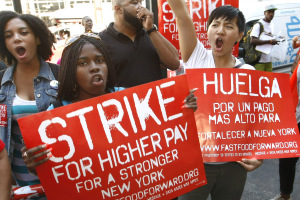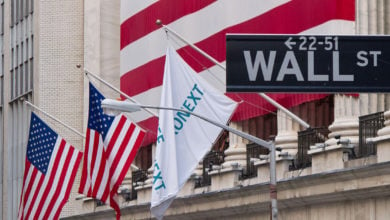
Originally published in Liberation Newspaper, April 2015
On the front pages of major publications and in self-congratulatory speeches, big news outlets and politicians alike are trumpeting a so-called economic recovery. According to the hype, unemployment is down, the stock market is up, and the people as a whole are on the march toward prosperity.
A quick look around reveals how hollow are the claims about the “recovery.” Workers with jobs are more insecure than ever. The number of workers relying on part-time jobs has reached an all-time high, climbing to 7.5 million last summer—a 70 percent increase from 2007.
The unemployment figures—officially at 5.5 percent—are equally deceiving.
The labor force participation rate—which measures the portion of the workforce either employed or looking for work—has been consistently falling for well over a decade. While part of this decline is due to “baby boomers” retiring, a huge number of employable people have simply given up looking for work. The real unemployment rate has not sharply declined, economists are just not including these “discouraged” workers in their calculations.
For workers with jobs, real wages—what people can actually buy accounting for inflation—have been essentially the same for the past 50 years. Adjusted for inflation, hourly wages averaged $19.18 in the United States in 1964. In 2014, they had only climbed to $20.67. For low-wage workers, there has actually been a significant decline; the federal minimum wage is only two-thirds of what it was in 1968.
Worker productivity has reached an all-time high in human history. The right-wing idea that poor and working people are lazy or ineffective is a lie. In fact, productivity has increased every decade since the 1940s. If workers are producing more than ever but are not earning higher real wages, where is all that wealth going? To the capitalist class.
Between 1979 and 2012, the poorest 20 percent of families saw their income decline by 12.1 percent, while the next poorest 20 percent saw virtually no change and the middle 20 percent saw a modest 8.4 percent increase. However, the wealthiest 5 percent of families saw their income skyrocket by 74.9 percent.
That is just income. When one takes into account assets like stocks and property, the inequality is more staggering. As of 2013, the bottom 90 percent of U.S. families controlled 25 percent of society’s wealth, but the top 3 percent held 54 percent of net worth.
In a racist country like the United States, Black, Latino and Native families are locked into the bottom rungs of the economic ladder, and suffer more intensely from inequality. While most politicians claim racism is a thing of the past, in reality this wealth gap is growing.
Looking worldwide, the domination of a tiny class of super-rich individuals becomes even clearer. The 85 richest people in the world have as much wealth as the poorest 50 percent of the world’s population: 3.5 billion people!
The imperialist ruling class in the United States gets rich by exploiting workers not just in this country but around the world, and by controlling natural resources, dominating trade routes and shaping the global financial system to their benefit. In the oil-rich Middle East and Africa, any government that stands in the way of the unquestioned dominance of big U.S. banks and corporations has been attacked by the Pentagon’s military machine. In Latin America, countries that have stood up to Wall Street’s dictates have been demonized and attacked.
If we are serious about winning justice and liberation, poor and working people in the United States need a global perspective, which means supporting the struggles of the working class all over the world.
Karl Marx’s assessment of capitalism over a century ago—that it accumulates wealth on one side and misery on the other—has been proven true. Regardless of who sits in the White House, this system does not work to meet people’s needs or to promote equality. Just the opposite: It functions only to make the rich richer. The only option is to overthrow and replace it.





